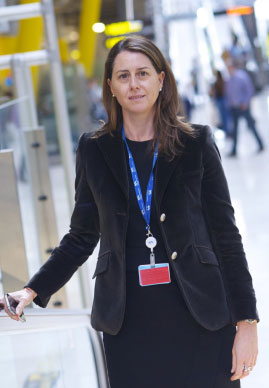
Elena Mayoral, Director, Adolfo Suárez Madrid-Barajas Airport: “Our main strength is our leadership in connectivity to Latin America. We are confident that we can be the perfect platform to connect Asia and Latin America.”
Adolfo Suárez Madrid-Barajas Airport is experiencing double-digit traffic growth this year, resulting from a proactive and successful route development strategy, while its passenger experience has also been enhanced through a major refurbishment in 2014. The airport’s successes were recognised at this year’s ACI EUROPE Best Airport Awards, where it was commended in the ‘Over 25 million passengers’ category. Airport Director Elena Mayoral outlined her vision to Samantha Jenkins.
Adolfo Suárez Madrid-Barajas Airport is a major economic driver for both the city and Spain as a whole. Indeed, it is an economic kingpin in a country successfully recovering from severe recession, which was highlighted at this year’s ACI EUROPE Best Airport Awards, where it was commended in the ‘Over 25 million passengers’ category.
Passenger numbers grew steadily in 2014 (+5.3%) and that trend has accelerated this year, with 12% growth in the period to end-August. “This has been the result of a dedicated effort to reinforce our airport marketing activities, working in cooperation with the Adolfo Suárez Madrid-Barajas Airport Route Development Committee, as well as an effort to improve passenger and airline satisfaction,” Elena Mayoral, Director, Adolfo Suárez Madrid-Barajas Airport, explained.
These strategic efforts resulted in the creation of a new hub in June 2014 by SkyTeam alliance member Air Europa, which operates in T1, T2 and T3 at Madrid-Barajas. Augmenting Iberia’s hub at T4 and T4S, this has reinforced the airport’s position as the main gateway between Europe and Latin America, with 24% of the total seat offer. It is also worth noting that Norwegian opened a base at Madrid-Barajas in June 2014.
This all points to the proactive work of the Adolfo Suárez Madrid-Barajas Airport Route Development Committee, which cooperates with the Regional Government of Madrid, City Council of Madrid, Madrid’s Chamber of Commerce, and Turespaña, to promote the airport’s connectivity. This is supported by an attractive incentive scheme to encourage passenger growth, new destinations, and increased transfer and cargo traffic.
Significantly, it was announced in September that Cathay Pacific Airways will launch a four times weekly Hong Kong-Madrid service in June 2016. “It is a route that reinforces our connectivity with China and Asia, and is in line with our marketing strategy to position our airport as the bridge between Latin America and Asia,” Mayoral asserted. “Our main strength is our leadership in connectivity to Latin America. We are confident that we can be the perfect platform to connect Asia and Latin America. In fact, it is noteworthy that it is the shortest route with one stop between China and some Latin American countries, such as Brazil, which is why Air China flies through Madrid to Sao Paulo.”
‘Plan Barajas 100’: Enhancing the passenger experience
Madrid-Barajas’ infrastructure consists of five terminals and four runways, meaning it has sufficient capacity to accommodate traffic growth for the foreseeable future. Throughput reached almost 42 million passengers in 2014, and the airport has a capacity of 70 million.
The airport underwent a major refurbishment in 2014, which provided 15,400sqm of new commercial space. There are 47 new restaurants, 27 different brands, ‘The Fashion Gallery’ which is the largest luxury store in a European airport, and ‘Air Rooms’ – an airport hotel.
Building on a desire for continual improvement, Mayoral explained that the airport has launched ‘Plan Barajas 100’ – 100 actions designed to enhance the passenger experience. Initiatives announced so far include improved security checkpoints, personalised services for passengers with reduced mobility (PRMs), new areas for families with children, and refurbishment of the flooring and restrooms. The aim, Mayoral commented, is to “create a unique experience at the airport”.
The ACI EUROPE Best Airport Awards judges also praised Madrid-Barajas for its achievement in implementing Airport Collaborative Decision Making (A-CDM). The airport completed integration of A-CDM in July 2014 – the first airport in Spain and the 12th in Europe to do so. Mayoral said the implementation has reduced average taxi times by 0.84 minutes, while saving almost 2.5 million litres of fuel.
Through these myriad developments, Madrid-Barajas is a symbol of modernity and progress. Looking ahead, the focus is on further improving the passenger experience through ‘Plan Barajas 100’, while the airport also has new ideas for its retail areas, which will be announced soon. Alongside these terminal developments, Madrid-Barajas’ route development continues apace. “Naturally, we will strive to merit the ACI EUROPE Best Airport Award next year!” Mayoral concluded.







